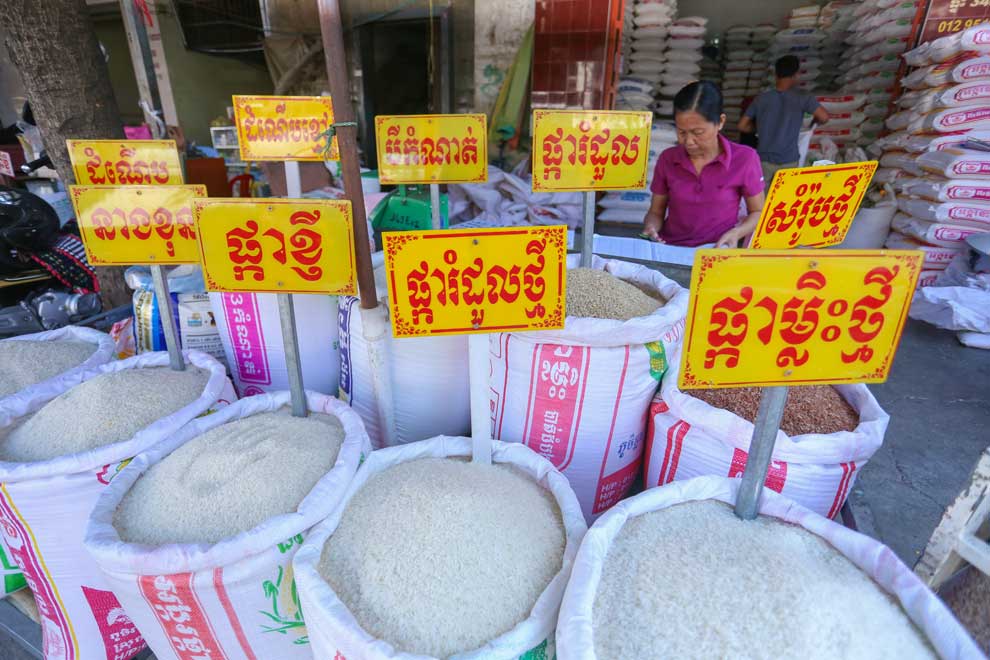
Agriculture Minister Dith Tina visits rice price situation in Battambang province on September 11. MAFF
Agriculture minister Dith Tina met with several Battambang provincial officials and rice exporters to discuss the current state of the commercial rice market, with the goal of ensuring that farmers can access markets and earn decent profits, while also contributing to the national economy.
Tina met with provincial governor Sok Lou and well-known mill owner Phou Puy – along with several other mill operators – on the morning of September 10, according to the Ministry of Agriculture, Forestry and Fisheries.
“During the meeting, the minister encouraged closer cooperation between millers and farmers. He also instructed local officials to investigate the creation of a ‘genetically pure rice seed’ network, especially the fragrant varieties of Sen Kra’op and Phka Romduol, both of which command high prices and have established markets,” said the ministry in a statement.
He also encouraged those who grow genetically pure rice to consider contracting their produce to millers through fixed contracts. This way, they will have a guaranteed market, making planning simpler.
Following the morning meeting, Tina visited the Tuol Samrong rice seed nursery in Thma Koul district’s Boeung Pring commune, where he urged the farmers to prepare large quantities of high-quality varieties in order to meet demand.
Ministry spokesman Khim Finan said it is important to keep rice prices at a competitive level, as it benefits farmers. This is one of the long-term strategies that will ensure the sustainability of this sector, he said.
Finan explained that the National Agriculture Development Policy 2022-30 lays out a comprehensive vision to develop the Kingdom’s agriculture sector into one which is “modern, competitive, inclusive, resilient to climate change and sustainable”. The policy also focuses on strengthening production and exports, reducing costs and increasing market competitiveness.
“To achieve this goal, we need to determine price points that are acceptable to both farmers and exporters. However, we cannot afford to ignore the last part of the puzzle – the consumers,” he said.
“If a product is too expensive, it is hard to export and consumers will be unhappy. This will lead to complaints by the producers. This is why it is essential to find a balance. The centre point is when farmers gain income, exporters have easy access to markets, and consumers are not charged unreasonable prices,” he added.

To find a common ground, he believes that production costs must be lowered, the scope of markets expanded and prices ensured for farmers.
Hun Lak, former chairman of the Cambodia Rice Federation (CRF) – the Kingdom’s apex rice industry body – explained that infrastructure and capital were both required to stockpile rice during the harvest period. The prices of electricity and shipping also need to be taken into consideration to ensure competitiveness.
Pakk Yourng, the CEO of Agribee (Cambodia), warned that increasing the price of rice could also spur rises for other products. He believes the most suitable course of action is to reduce costs and risks, while increasing productivity.
He encouraged precautionary measures against factors that could affect the costs of rice production, including irrigation and labour. He also encouraged farmers to learn more about the benefits of insurance.
He also called for the cessation of the use of low-yield rice varieties. “Stakeholders should be aiming to produce between seven and eight tonnes of rice per hectare. If a hectare can produce eight tonnes, farmers will still earn a decent income, even if prices are low,” he said.
Yourng observed that prices are fluctuating very quickly, meaning traders and wholesalers are wary of buying at high prices. He explained that they tended to buy only when prices had been table for one or two weeks.







